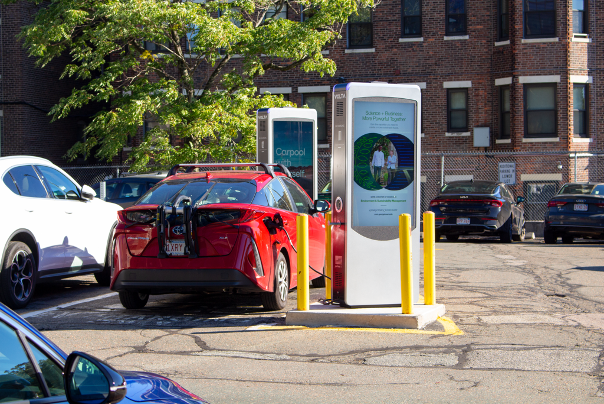Electric vehicles (EVs) currently make up about 1% of the cars in the United States. Economic and technology analysts expect this number to soar up to at least 70% by 2050, drastically increasing the amount of energy Americans are pulling from the electric grid.
Cars in America guzzle 369 million gallons of gas every day. Gasoline stores chemical energy in bonds between atoms, which cars convert into usable energy that rotates their wheels. However, EVs store electrical energy, supplied by the electric grid, in their batteries. Full adoption of EVs would require an added 11% increase in the amount of energy the grid currently produces. Electric grid experts warn that America is nowhere near prepared.
Electric grid experts warn that America is nowhere near prepared.
In this expansion, operators and planners will have to delicately balance the energy drawn by consumers with the energy produced and stored by the grid. Long-term support of the rapid adoption of EVs will require building out green energy sources, battery storage capabilities, and accessible charging stations that encourage drivers to spread out their electricity demand.
The rise of inequity and electricity demand
The spread of EVs brings a hopeful but complicated vision of the future. As America begins to build its future grid, single-family homeowners can install their own EV chargers, batteries, and even rooftop solar, capitalizing on the new electric grid’s full flexibility and financial benefits. Renters and city dwellers are not afforded the same luxury. People living in apartments act solely as energy consumers, unable to sell the energy they produce from solar panels or store in batteries to electricity providers.
The Boston-based activist group Green Energy Consumer Alliance’s Drive Green program focuses on increasing EV adoption through informative webinars and EV test drive events. The group works to inform landlords on how to easily install home EV chargers and familiarize renters with public charging stations around them.
The higher sticker price of EVs creates a lot of hesitation in consumers. Right now, “people buying EVs tend to be older and wealthier,” said Kelly Shin, an Electric Vehicle Program Associate at the organization.
Even so, the price of lithium-ion batteries, the most expensive component of electric vehicles, has plummeted in the past 20 years, faster than many experts predicted. The sticker price of EVs is expected to drop below that of gas cars by the end of the decade, even without including cost savings from ditching gasoline and lower overall maintenance costs. Paired with a renewed investment from the federal and state governments in transitioning to clean transportation, this has led to recent predictions that EV sales will skyrocket beyond earlier estimates.
The sticker price of EVs is expected to drop below that of gas cars by the end of the decade, even without including cost savings from ditching gasoline and lower overall maintenance costs.
The stress EVs will place on the grid is not only due to the amount of energy EVs need, but when they need it. The current grid has almost no capability of storing energy: energy must be used after its production. As the evening sinks in, energy use peaks as people turn on lights and appliances in their homes. This increase in demand already requires controllable energy types — such as fossil fuels, coal, natural gas, and nuclear power plants — to increase their output. Adding everyone charging their EV in the evening after work and a new dependency on daytime solar energy exacerbates the discrepancy between peak demand and peak supply of energy.
Building out battery infrastructure creates flexibility to offset when electricity is generated and when it’s used. Batteries can store energy produced by solar in the middle of a warm, sunny day when demand is low and discharge that energy as night falls. But building a nationwide battery infrastructure is costly, and many experts argue that the grid should mainly use battery infrastructure as a safeguard during extreme events and grid failures, not in day-to-day grid balancing.
A Stanford University research group performed a case study on how different charging infrastructures would impact the Western U.S. electric grid of 2035. The team found that simply increasing people’s access to public and workplace chargers had a more significant effect than scheduled charging.
The public charger
In a grid balanced with scheduled charging, when someone comes home from work and plugs their EV in, it doesn’t immediately charge. The owner would input when they plan on leaving next, and the charger waits until electricity demand — and prices — drop once people turn off the lights and head to bed. It then coordinates with other chargers in the neighborhood to spread out the energy demand. Public superchargers work similarly. Users schedule when they plan to arrive at and depart from a charger with an app, and the charger’s computer coordinates these requests to optimize charging times.
In the Stanford team’s 2035 electric grid models, public and workplace chargers shifted the energy demand more in line with the midday peak of energy production from new solar. While the computer scheduling method can help distribute the evening demand peak throughout the night, it’s only capable of marginal shifts and adjustments. An EV owner may only have their car plugged in for a few hours, so the charging time can only shift between those hours. Conversely, investing in public charging infrastructure can shift nighttime charging demand to midday.
Day charging might not be the answer for every community, especially if they’re becoming increasingly dependent on overnight wind or hydropower. Regardless, how communities design charging infrastructure matters, and the Stanford team urges policymakers to begin incentivizing and planning for charging stations that make charging during the peak of energy generation most convenient.
Regardless, how communities design charging infrastructure matters, and the Stanford team urges policymakers to begin incentivizing and planning for charging stations that make charging during the peak of energy generation most convenient.
“Charging infrastructure has a really big impact on the grid,” said Siobhan Powell, who led the study and recently finished her PhD with the Stanford team. “It totally changes what time drivers are using electricity.”
Studies on lower EV adoption levels typically focus on EV owners living in single-family homes. However, as researchers begin to study the high levels of adoption that are likely in the 2030s and beyond, people living in apartments, who previously had little access to EVs, become an increasingly important demographic. Public and workplace charging infrastructure provide universal and equitable access to charging, including for those living in apartments.
“It’s a fortunate result that public and workplace charging also happens to be the best option for the grid,” Powell said.


